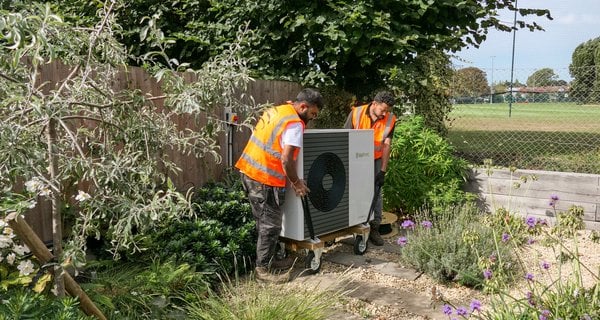Initial household reactions to clean heat neighbourhoods
Prior to the activities, we began each session by introducing the concept of a clean heat neighbourhood through a short spoken description, unaccompanied by visuals or prompts. We explained it as a coordinated, area-based shift away from gas heating to cleaner systems, like heat pumps, supported locally rather than households navigating the shift alone. This was an intentional way to test the concept in the abstract, before layering in any of the messaging touchpoints that might influence perception.
Our aim was to meet people where they are, to understand what ‘clean heat neighbourhood’ evokes on its own. Is it something they care about? Does it feel relevant to them? What assumptions, questions, or hesitations arise before any framing is introduced?
This zoomed-out first step gave us a macro-level view, a way to hear how people initially interpret the idea of a clean heat neighbourhood, and how they filter it through their own personal context. It also set the stage for the rest of the session. By starting with open-ended reactions, we were better positioned to observe how and if people’s understanding shifted once we introduced sequenced communications later on.
What we heard
Most participants expressed openness or cautious interest, but personal relevance varied, often shaped by their housing type, financial concerns, or trust in coordination.
Key themes
Relevance is shaped by personal values
Some participants were motivated by environmental concerns or a desire to leave a better world for the next generation. Some connected clean heat neighbourhoods to collective responsibility towards a shared problem; the climate crisis, and to the idea of community-based neighbourhood-level change:
“We are in a climate crisis and have been for many years. The government is not doing enough to bring us closer to green energy or to slow down the climate issues.” "When I had my son, he's three, you don't think about your own life in the same way. He's going to outlive me and I want the world to be a better place for him."
Perception of feasibility depends on housing context
Some immediately assessed whether it fits their home and often judged relevance based on where they lived. Tenements, shared flats, and conservation areas raised questions about whether a clean heat neighbourhood could be implemented practically. Some felt a clean heat neighbourhood made more sense in new builds than in retrofits:
“Makes me think of new builds, an estate getting built, they're all getting built with solar panels and heat pumps, and that to me makes more sense to have from the beginning.” “Seeing a clean heat neighbourhood in this estate, (10-15 years old), to come in and change everything, the infrastructure required would be huge. I don't think we’ll manage to get the consent of everybody.”
Coordination increases confidence
Some generally preferred the idea of joining something local and supported, rather than navigating heating choices individually. Several described clean heat neighbourhoods as more trustworthy and less risky than doing it alone. It felt logical and helpful, particularly if it removed burden from the individual and if someone led it:
“Getting the word out there that there are alternative options and being able to do it together, collectively rather than just being one person that goes out there on their own might give people more confidence.”
Cost is universal
Everyone mentioned cost, though not always first. For some, affordability was the most immediate concern. For others, cost surfaced after considerations around environmental benefits, housing constraints or personal timing. It was either the strongest driver, or the condition. Regardless of when it appeared, it shaped how realistic and attractive the idea felt:
“I think cost is number one, isn't it for most people?” “We're in an arms race of cost, it's only going up with fossil fuels anyway.”
Key themes from initial household responses to clean heat neighbourhoods





